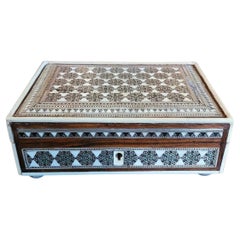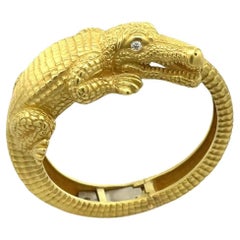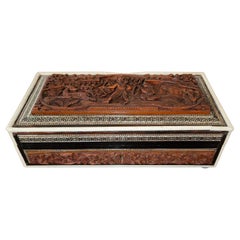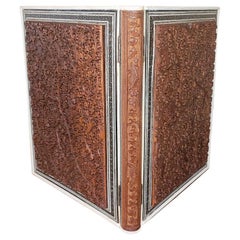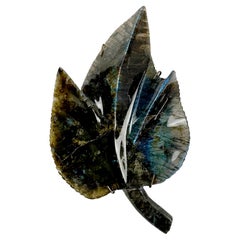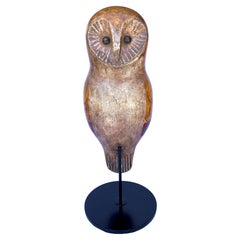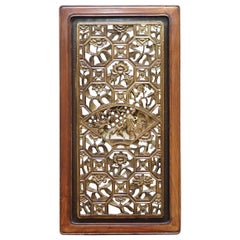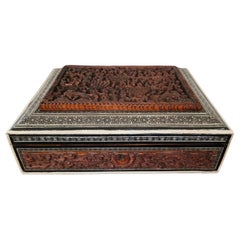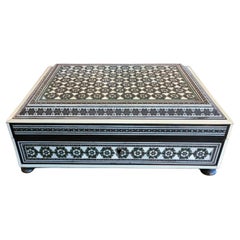Precious Stone Furniture
17
to
404
224
17
17
17
1
1
1
2
6
9
3
2
1
1
987
11,292
9,966
4,872
4,038
6
6
6
4
3
1
Item Ships From: Dallas
Material: Precious Stone
Labradorite Carved Owl
Located in Dallas, TX
Labradorite carved owl with glass eyes perched on a on stone base. American, 20th century.
Category
Late 20th Century American Precious Stone Furniture
Materials
Sandstone
19C Anglo Indian Bombay MOP Sadeli Mosaic Trinket Box
Located in Dallas, TX
PRESENTING a LOVELY 19C Anglo Indian Bombay MOP (Mother of Pearl) Sadeli Mosaic Trinket Box from circa 1875-85.
Gorgeously detailed and hand-crafted ‘sadeli mosaic’ inlay, from the Bombay Area, with deep greens with silver, pewter, mother of pearl, bone and ebony in geometric patterns.
The box case, is made of sandalwood but completely covered in MOP, bone, faux ivory, ebony and mosaic inlay.
Edged with faux ivory and banded with a different pattern of sadeli mosaic.
Some minor damage to the top (repair is obvious in pics) and ivorine replacements to some edging, but it still a BEAUTIFUL BOX and of real QUALITY!
The mosaic work is FABULOUS!
Box opens to reveal its original blue velvet lining.
It sits on 4 (recently added) silvered button feet.
SADELI MOSAIC: “Anglo Indian boxes were made in India for the English residents from the early part of the 18th century. They were brought back or sent back to England usually by the people who had commissioned them. From the beginning of the nineteenth century they were imported more commercially, although not in any significant numbers until the middle decades. They were very highly valued, especially the early ones, to the extent that the designs were copied on late 19th and early 20th century tins.
The ancient art of Sadeli Mosaic is said to have been introduced from Shiraz in Persia via Sind to Bombay, a long time before the Anglo Indian boxes were made. It was a technique, which required a high degree of skill and patience. It was executed very lavishly, in that the frequent cuts wasted a great amount of the precious materials used. The workmanship was however more than commensurable to the value of the materials.
Ivory, silver, pewter (or other metals), wood and horn were cut into faceted rods which were bound together to form geometric patterns. When the glue has set, the rods were sliced in transverse sections. This gave the maker a number of angled circular pieces in the original pattern. Several variations of patterns could be achieved by combining the materials in different ways. The ivory was sometimes dyed green to give an extra color.
The mosaic pieces in a combination of patterns, often separated by ivory, ebony, horn or silver stringing were used to veneer sandalwood boxes. In the early boxes, which date from the turn of the 18th to the 19th century, there are large panels of mosaic covering tops and sides of boxes. It took incredible skill to cover such large areas without any shakes or wavering of the pattern. The corners and joins on these boxes are impeccably matched.
The makers (reputed to be Persian) of Sadeli mosaic made in the first two decades of the 19th century displayed a total understanding of the qualities of the different materials they used. They combined substances, which can expand and contract according to atmospheric conditions with others, which are hard and unyielding. The result was a sharp definition of the lines and patterns, which made up the whole design.
On the early boxes the designs look deceptively simple. The fact is, they emerged from a culture, which had mastered geometry and understood how to generate a pattern from a set number of points. The patterns are so harmoniously combined that their incredible complexity is not immediately apparent.
The earliest Sadeli boxes...
Category
Late 19th Century Indian Anglo-Indian Antique Precious Stone Furniture
Materials
Silver
Kieselstein Cord Diamond 18k Yellow Gold 3D Alligator Cuff Bracelet
Located in Dallas, TX
This authentic Barry Kieselstein-Cord bracelet is finely crafted from 18k yellow gold featuring an intricate and detailed 3D sculpted full figure alligator, from the larger part with...
Category
1980s American Art Deco Vintage Precious Stone Furniture
Materials
Gold Leaf
19C Anglo Indian Carved Padouk Wood and Sadeli Mosaic Box
Located in Dallas, TX
PRESENTING A LOVELY 19th century Anglo-Indian Carved Padouk Wood and Sadeli Mosaic Box, featuring a carving of a Hunt Scene.
Made circa 1870 in Bombay, India during the Rule of th...
Category
Late 19th Century Indian Anglo-Indian Antique Precious Stone Furniture
Materials
Silver, Pewter
19C Anglo Indian Highly Carved Padouk and Mosaic Folio Cover
Located in Dallas, TX
PRESENTING A RARE AND DESIRABLE 19C Anglo Indian Highly Carved Padouk and Mosaic Folio Cover.
This is a VERY RARE piece of Anglo-Indian and British Victorian Colonial history!
...
Category
Late 19th Century Indian Anglo Raj Antique Precious Stone Furniture
Materials
Bone, Precious Stone, Sandalwood
Leaf Carved from Mossy Forrest Green Labradorite
Located in Dallas, TX
An intriguing custom carved and polished sculptural leaf. Made from Labradorite, a mossy forest green color.
In very good condition. Some gentle wear and aging consistent with age a...
Category
20th Century Precious Stone Furniture
Materials
Stone
Leaf Carved and Polished from Mossy Forest Green Lobrandite
Located in Dallas, TX
An intriguing custom carved and polished sculptural leaf. Made from labradorite, a mossy forest green color.
In good condition. Some gentle wear and aging consistent with age and us...
Category
20th Century Unknown Precious Stone Furniture
Materials
Precious Stone
Leaf Hand Carved and Polished from Desert Jasper
Located in Dallas, TX
An intriguing custom carved and polished sculptural leaf. Made from desert jasper in a dark gray center and a sandy desert red on the outside.
In very good condition. Some gentle we...
Category
20th Century Unknown Precious Stone Furniture
Materials
Precious Stone
Leaf Carved and Polished from Warm Chestnut Jasper
Located in Dallas, TX
An intriguing custom carved and polished sculptural leaf. Made from Jasper in a warm chestnut color.
In good condition. Some gentle wear and aging consistent with age and use. One p...
Category
20th Century Unknown Precious Stone Furniture
Materials
Precious Stone
19C Anglo Indian Highly Carved Padouk Sadeli Mosaic Scroll Box of Hindu Gods
Located in Dallas, TX
PRESENTING AN ABSOLUTELY STUNNING AND EXCEPTIONAL 19C Anglo Indian Highly Carved Padouk Sadeli Mosaic Scroll Box of Hindu Gods from circa 1870-80.
The box case is made from sandalwood with highly hand-carved padouk wood reliefs on all sides and banded and edged in fabulous ‘Sadeli Mosaic’, made from faux ivory/bone, ebony, silver, semi-precious green stone, etc., in various geometric patterns.
The carved lid of this box is EXCEPTIONAL!
It is HIGHLY HAND-CARVED and depicts 13 Hindu Gods: Vishnu, Shiva, Harihara, etc., in 9 oval shaped reliefs, surrounded by foliage etc.
The sides and rear have highly carved foliage relief panels.
The lid opens to reveal the original red velvet lining (also on the base) in SUPERB CONDITION throughout.
The QUALITY of the ‘sadeli mosaic’ work is EXCEPTIONAL all over.
It has its key and working lock.
It sits on it’s 4 original brass turned ball feet.
THIS IS A HIGH QUALITY & VERY RARE AND DESIRABLE BOX!
SADELI MOSAIC: “Anglo Indian boxes were made in India for the English residents from the early part of the 18th century. They were brought back or sent back to England usually by the people who had commissioned them. From the beginning of the nineteenth century they were imported more commercially, although not in any significant numbers until the middle decades. They were very highly valued, especially the early ones, to the extent that the designs were copied on late 19th and early 20th century tins.
The ancient art of Sadeli Mosaic is said to have been introduced from Shiraz in Persia via Sind to Bombay, a long time before the Anglo Indian boxes were made. It was a technique, which required a high degree of skill and patience. It was executed very lavishly, in that the frequent cuts wasted a great amount of the precious materials used. The workmanship was however more than commensurable to the value of the materials.
Ivory, silver, pewter (or other metals), wood and horn were cut into faceted rods which were bound together to form geometric patterns. When the glue has set, the rods were sliced in transverse sections. This gave the maker a number of angled circular pieces in the original pattern. Several variations of patterns could be achieved by combining the materials in different ways. The ivory was sometimes dyed green to give an extra color.
The mosaic pieces in a combination of patterns, often separated by ivory, ebony, horn or silver stringing were used to veneer sandalwood boxes. In the early boxes, which date from the turn of the 18th to the 19th century, there are large panels of mosaic covering tops and sides of boxes. It took incredible skill to cover such large areas without any shakes or wavering of the pattern. The corners and joins on these boxes are impeccably matched.
The makers (reputed to be Persian) of Sadeli mosaic made in the first two decades of the 19th century displayed a total understanding of the qualities of the different materials they used. They combined substances, which can expand and contract according to atmospheric conditions with others, which are hard and unyielding. The result was a sharp definition of the lines and patterns, which made up the whole design.
On the early boxes the designs look deceptively simple. The fact is, they emerged from a culture, which had mastered geometry and understood how to generate a pattern from a set number of points. The patterns are so harmoniously combined that their incredible complexity is not immediately apparent.
The earliest Sadeli boxes...
Category
19th Century Indian Anglo-Indian Antique Precious Stone Furniture
Materials
Silver
Matl Mexican Silver Santos Style Figure
Located in Dallas, TX
A Rivera Nuestra Senora de la Asuncion in Tonaya adorned with turquoise and amethyst! Signed on back. circa 1950s, Mexico.
Category
1950s Mexican Vintage Precious Stone Furniture
Materials
Silver
18 C, Indo-Portuguese Vargueno Mini Cabinet
Located in Dallas, TX
Presenting a fabulously rare 18c Indo-Portuguese Vargueno mini cabinet.
Extremely rare, highly important and desirable colonial piece !
It is an In...
Category
Late 18th Century Indian Anglo-Indian Antique Precious Stone Furniture
Materials
Brass
Vintage Pink Quartz Sculpture Lamps
Located in Dallas, TX
Interesting pair of vintage pink quartz sculptural lamps. These are very fine quality and create an upscale look!.
Category
Mid-20th Century Italian Precious Stone Furniture
Materials
Rose Quartz
19C Anglo Indian Sadeli Mosaic Greeting Card Case
Located in Dallas, TX
Presenting a superb 19C Anglo Indian Sadeli Mosaic greeting card case.
Made in or around Bombay, India circa 1880.
This is a greeting card case used for holding your greeting cards or business cards of the day !
The body of the case is made from sandalwood and it is fully overlaid with bone and highly intricate Sadeli Mosaic made up of thousands of micro mosaic pieces of bone, ebony, silver/pewter and semi precious stone.
The workmanship is stupenduous !!!!
This case is almost museum quality. One or two very, very minor losses of mosaic mainly where the top meets the body but otherwise near mint !
SADELI MOSAIC: “Anglo Indian boxes were made in India for the English residents from the early part of the 18th century. They were brought back or sent back to England usually by the people who had commissioned them. From the beginning of the nineteenth century they were imported more commercially, although not in any significant numbers until the middle decades. They were very highly valued, especially the early ones, to the extent that the designs were copied on late 19th and early 20th century tins.
The ancient art of Sadeli Mosaic is said to have been introduced from Shiraz in Persia via Sind to Bombay, a long time before the Anglo Indian boxes were made. It was a technique, which required a high degree of skill and patience. It was executed very lavishly, in that the frequent cuts wasted a great amount of the precious materials used. The workmanship was however more than commensurable to the value of the materials.
Ivory, silver, pewter (or other metals), wood and horn were cut into faceted rods which were bound together to form geometric patterns. When the glue has set, the rods were sliced in transverse sections. This gave the maker a number of angled circular pieces in the original pattern. Several variations of patterns could be achieved by combining the materials in different ways. The ivory was sometimes dyed green to give an extra color.
The mosaic pieces in a combination of patterns, often separated by ivory, ebony, horn or silver stringing were used to veneer sandalwood boxes. In the early boxes, which date from the turn of the 18th to the 19th century, there are large panels of mosaic covering tops and sides of boxes. It took incredible skill to cover such large areas without any shakes or wavering of the pattern. The corners and joins on these boxes are impeccably matched.
The makers (reputed to be Persian) of Sadeli mosaic made in the first two decades of the 19th century displayed a total understanding of the qualities of the different materials they used. They combined substances, which can expand and contract according to atmospheric conditions with others, which are hard and unyielding. The result was a sharp definition of the lines and patterns, which made up the whole design.
On the early boxes the designs look deceptively simple. The fact is, they emerged from a culture, which had mastered geometry and understood how to generate a pattern from a set number of points. The patterns are so harmoniously combined that their incredible complexity is not immediately apparent.
The earliest Sadeli boxes...
Category
Late 19th Century Indian Anglo Raj Antique Precious Stone Furniture
Materials
Bone, Precious Stone, Ebony
Mid-Century Italian Pietra Dura Plaques in Carved Gilt Frames, Set of Four
Located in Dallas, TX
Decorate an office or a study with this elegant and colorful set of antique wall decor. Crafted in Italy circa 1950, each stone plaque is set in a ornate and carve gilt wood frame. E...
Category
Mid-20th Century Italian Precious Stone Furniture
Materials
Marble
Antique Venetian Embroidery Pillow by Eleganza Italiana
Located in Dallas, TX
19th century Venetian silver and gold thread embroidery with its original genuine turquoise stone embellishments and three tassels comprise the centre decoration. It is hand sewn on pale green Italian silk and bordered with a rare 19th century handmade lace and vintage silver thread beaded trim. Crafted by an Italian artisan. Down filled. One of a kind. Unique creation by Eleganza Italiana.
Category
19th Century Italian Baroque Antique Precious Stone Furniture
Materials
Metallic Thread
18th Century Scottish Horn and Polished Stone Tea/Tobacco Caddy
Located in Dallas, TX
PRESENTING A BEAUTIFUL AND EXTREMELY RARE 18th Century Scottish Horn and Polished Stone Tea Caddy or Tobacco Jar.
This is a piece of Scottish history !!...
Category
18th Century Scottish George II Antique Precious Stone Furniture
Materials
Bone, Horn, Precious Stone
Related Items
Folk Art Carved and Painted Owl Decoy, USA, 1900's
Located in Buenos Aires, Olivos
Folk Art carved and painted owl decoy, USA 1900's
A decorative barn owl carving decoy
Original paint with even wear.
Mounted over a new iron stand.
Category
20th Century American Folk Art Precious Stone Furniture
Materials
Wood
Chinese Export circa 1900 Gold Leaf Painted Fret Work Carved Wall Panel in Teak
Located in GB
We are delighted to this lovely circa 1900 hand carved and paint Chinese Export wall panel
A very good looking and well-made piece, would suit any setting its ornately carved in s...
Category
Early 1900s Chinese Chinese Export Antique Precious Stone Furniture
Materials
Teak
H 31.89 in W 16.74 in D 1.19 in
Mosaic Middle Eastern Moorish Trinket Box
By Mamluke
Located in North Hollywood, CA
Handcrafted marquetry Middle Eastern Moorish wood inlay micro mosaic with miniature hand painted scene of birds.
Handcrafted khatam wooden box ...
Category
20th Century Lebanese Moorish Precious Stone Furniture
Materials
Wood
Japanese Owl Hand Carved Rosewood Sculpture
Located in Douglas Manor, NY
3-983 Japanese owl hand carved rosewood sculpture.
Category
1930s Vintage Precious Stone Furniture
Materials
Hardwood
Vintage Indian Cloisonné Round Brass Trinket Box
Located in Chicago, IL
Vintage cloisonné round trinket box, with black and gold flower and foliage decorating the lid. Made in India sticker on bottom.
Category
20th Century Indian Anglo-Indian Precious Stone Furniture
Materials
Metal, Brass
Painted Decorated Anglo Indian Box with Elephants
Located in Palm Beach, FL
A very charming Anglo Indian painted decorated box with elephant, people, peacocks and mystical animal motifs, an outside bracket base and a brass...
Category
Early 20th Century Indian Anglo-Indian Precious Stone Furniture
Materials
Hardwood
Imperial Faberge Carved Labradorite Ostrich on Nephrite Base, 20th Century
By Fabergé
Located in New York, NY
An imperial Faberge carved Labradorite ostrich on nephrite base, 20th century
In original box. Limited Edition: 18/250
Measures: 7″ high x 3.5″ deep x...
Category
20th Century Unknown Precious Stone Furniture
Materials
Multi-gemstone
No Reserve
H 7 in W 2 in D 3.5 in
Art Deco Hand-Carved Relief in Gold Leaf
Located in Los Angeles, CA
Art Deco hand-carved three-dimensional wooden relief based on the design by Picot for the "Folies Bergères" theater in Paris. Shown in gold leaf, also available in silver leaf. For ...
Category
21st Century and Contemporary American Art Deco Precious Stone Furniture
Hand-Carved Oakwood Owl Sculpture with Glass Eyes, Germany, 1930s
Located in Barntrup, DE
Art Deco style hand-carved oakwood owl sculpture, Germany, circa the 1930s.
This beautiful naturalistically carved dark brown wooden owl with glass eyes, sitting on a wooden base wi...
Category
1930s German Art Deco Vintage Precious Stone Furniture
Materials
Wood, Oak
Mid 20th Century Anglo Indian Carved Wood Jewelry Box Kashmir India
Located in North Hollywood, CA
Vintage hand carved wood jewelry trinket storage box with brass inlaid.
Hand-carved large wooden Anglo-Raj jewelry box. Found in Kashmir, India.
Mi...
Category
Mid-20th Century Indian Anglo-Indian Precious Stone Furniture
Materials
Brass
19th C. Anglo-Indian Hand Carved 4-Section Tea Caddy Inset W/ Tin Manganese Tile
Located in Atlanta, GA
Anglo Indian, early 19th century.
A highly unusual Antique hand carved 4-section tea caddy. The box which features a carved ribbon edge hinged lid, which opens to reveal four individually wood lined tea boxes with brass finial handles. The body is not only beautifully carved with blooming floral designs but it is also inset with 8 classical tin Manganese Delft...
Category
19th Century British Anglo-Indian Antique Precious Stone Furniture
Materials
Brass
H 7.875 in W 12.875 in D 12.875 in
Anglo Raj Hand-Carved Decorative Jewelry Box
By Rajhastani
Located in North Hollywood, CA
Hand-carved Anglo Raj early 20th century carved wood box richly decorated overall with arabesques and floral carving.
Hinged lid shallow relief carving with interior lined with red r...
Category
Early 20th Century Indian Anglo Raj Precious Stone Furniture
Materials
Sandalwood
Previously Available Items
19th Century Anglo Indian Highly Carved Sandalwood and Sadeli Mosaic Box
Located in Dallas, TX
PRESENTING A VERY NICE 19th century Anglo Indian Highly Carved Sandalwood and Sadeli Mosaic Box.
Late 19th century, circa 1880, Anglo-Indian Box from the “Time of the Raj” made in...
Category
Late 19th Century Indian Anglo-Indian Antique Precious Stone Furniture
Materials
Silver, Pewter
Exceptional 19th Century Anglo Indian Sadeli Mosaic Trinket Box
Located in Dallas, TX
PRESENTING A SUPERB AND EXCEPTIONAL EXAMPLE of a mid-19th century Anglo-Indian Sadeli Mosaic Trinket Box.
This one is in BEAUTIFUL CONDITION for its age!
From circa 1850-1860 and made in the Region of Bombay, India for the British market.
The ‘sadeli mosaic’ on this box, is classically an early version, of this type of mosaic work and is ‘coarse’ to the touch. Because of this, most boxes with this type of mosaic, have not survived intact for 170 years, without major losses to the mosaic, from dusting, cleaning, etc.
This box only has only had ONE very minor loss of mosaic to the top, which has been repaired and is hardly noticeable, otherwise it is in GREAT ORIGINAL CONDITION!
The faux ivory banding is even original to the piece.
The ‘Sadeli Mosaic’ on this box is ‘striking’, with gorgeous geometric patterns of silver, pewter, bone, stained bone (green) and ebony.
The box case, itself, is made of sandalwood, but it is completely covered in sadeli mosaic and faux ivory and ebony veneer.
The lid is banded with a different sadeli mosaic pattern.
From circa 1850-60 and made in the Region of Bombay, India for the British market.
The interior is lined in its original red velvet lining.
The box sits on it’s original 4 brass bulbous feet and the red velvet is also on the base underside.
The ‘QUALITY’ of this box is evident from the EXCEPTIONAL Sadeli mosaic work, but also the lock which is an early British ‘Lever’ Lock is a sign of real quality.
This is ONE for the SERIOUS COLLECTOR!
SADELI MOSAIC: “Anglo Indian boxes were made in India for the English residents from the early part of the 18th century. They were brought back or sent back to England usually by the people who had commissioned them. From the beginning of the nineteenth century they were imported more commercially, although not in any significant numbers until the middle decades. They were very highly valued, especially the early ones, to the extent that the designs were copied on late 19th and early 20th century tins.
The ancient art of Sadeli Mosaic is said to have been introduced from Shiraz in Persia via Sind to Bombay, a long time before the Anglo Indian boxes were made. It was a technique, which required a high degree of skill and patience. It was executed very lavishly, in that the frequent cuts wasted a great amount of the precious materials used. The workmanship was however more than commensurable to the value of the materials.
Ivory, silver, pewter (or other metals), wood and horn were cut into faceted rods which were bound together to form geometric patterns. When the glue has set, the rods were sliced in transverse sections. This gave the maker a number of angled circular pieces in the original pattern. Several variations of patterns could be achieved by combining the materials in different ways. The ivory was sometimes dyed green to give an extra color.
The mosaic pieces in a combination of patterns, often separated by ivory, ebony, horn or silver stringing were used to veneer sandalwood boxes. In the early boxes, which date from the turn of the 18th to the 19th century, there are large panels of mosaic covering tops and sides of boxes. It took incredible skill to cover such large areas without any shakes or wavering of the pattern. The corners and joins on these boxes are impeccably matched.
The makers (reputed to be Persian) of Sadeli mosaic made in the first two decades of the 19th century displayed a total understanding of the qualities of the different materials they used. They combined substances, which can expand and contract according to atmospheric conditions with others, which are hard and unyielding. The result was a sharp definition of the lines and patterns, which made up the whole design.
On the early boxes the designs look deceptively simple. The fact is, they emerged from a culture, which had mastered geometry and understood how to generate a pattern from a set number of points. The patterns are so harmoniously combined that their incredible complexity is not immediately apparent.
The earliest Sadeli boxes...
Category
Mid-19th Century Indian Anglo-Indian Antique Precious Stone Furniture
Materials
Silver
18C Anglo Indian Sadeli Mosaic Sarcophagus Sewing Box
Located in Dallas, TX
PRESENTING AN EXCEPTIONALLY RARE & IMPORTANT late 18C Anglo Indian Sadeli Mosaic Sarcophagus Sewing Box.
VERY, VERY EARLY Sadeli Mosaic piece, which is what makes it all the more important!
Made in the area of Bombay, India circa 1780-1800.
The box is in a classic Regency Era Sarcophagus form, very reminiscent of an Egyptian/Summarian Coffins/Tombs. This form features regularly in Tea Caddies of that period and helps us identify this piece as, most definitely, late 18th Century.
The box is flanked on either side by scroll shaped ends, with a raised platform on the lid.
The box is completely covered in an early version of ‘Sadeli Mosaic’.
It is edged/banded in faux ivory and ebony stringing.
The box case is made of sandalwood.
This box is a really EARLY example of this type of mosaic work.
The craftsmen of the Bombay area became famous for their ‘sadeli mosaic’ work, through the 19th Century and most examples of boxes with this mosaic, date from the mid-19th Century up to the early 20th Century.
As the surface of the early sadeli work, is quite rough/coarse to the touch, it was very difficult to maintain, as dusting with a cloth, would often ‘lift off’ some of the mosaic. Thus, very, very few pieces have survived fully intact.
There is no disputing that this box has lived a ‘full life’, BUT, that is to be expected of most Sadeli Mosaic pieces from 1880 … let alone one, from 100 years earlier than that!
It is remarkable that it has survived at all!
If this were in better condition, it would be in a museum and/or would have a VERY LARGE price tag of multiples of our asking price!
There has been quite a loss of mosaic and banding on the exterior, but the loss has been halted, by a gentle application of filler and clear lacquer.
The interior of the box is SUPERB, it is ‘pretty much’ in ORIGINAL CONDITION!
The mirror is the original and removeable. It is edged/banded with sadeli mosaic, bone and ebony.
It has a removeable base tray with various lidded compartments.
Original red velvet lining on the inside of the lid and under the tray.
The tray has 3 Sadeli mosaic lidded compartments (1 large and 2 small).
The ‘sadeli’ work on the lids, is exceptional and very well preserved, with only very minor losses. You can really see the quality of the original mosaic work on these!
It has a removeable pin cushion, banded in bone and hand decorated and the original burgundy velvet.
There are 4 bone lids for holding the 6 faux ivory thread spools, thimble, and hand decorated thread cannisters.
There is 1 long bone lid for storage underneath.
The interior is pretty much as good as it gets!
It sits on 4 brass ball feet.
THIS IS AN EXCEPTIONALLY RARE 18C MINIATURE SEWING BOX!
SADELI MOSAIC: “Anglo Indian boxes were made in India for the English residents from the early part of the 18th century. They were brought back or sent back to England usually by the people who had commissioned them. From the beginning of the nineteenth century they were imported more commercially, although not in any significant numbers until the middle decades. They were very highly valued, especially the early ones, to the extent that the designs were copied on late 19th and early 20th century tins.
The ancient art of Sadeli Mosaic is said to have been introduced from Shiraz in Persia via Sind to Bombay, a long time before the Anglo Indian boxes were made. It was a technique, which required a high degree of skill and patience. It was executed very lavishly, in that the frequent cuts wasted a great amount of the precious materials used. The workmanship was however more than commensurable to the value of the materials.
Ivory, silver, pewter (or other metals), wood and horn were cut into faceted rods which were bound together to form geometric patterns. When the glue has set, the rods were sliced in transverse sections. This gave the maker a number of angled circular pieces in the original pattern. Several variations of patterns could be achieved by combining the materials in different ways. The ivory was sometimes dyed green to give an extra color.
The mosaic pieces in a combination of patterns, often separated by ivory, ebony, horn or silver stringing were used to veneer sandalwood boxes. In the early boxes, which date from the turn of the 18th to the 19th century, there are large panels of mosaic covering tops and sides of boxes. It took incredible skill to cover such large areas without any shakes or wavering of the pattern. The corners and joins on these boxes are impeccably matched.
The makers (reputed to be Persian) of Sadeli mosaic made in the first two decades of the 19th century displayed a total understanding of the qualities of the different materials they used. They combined substances, which can expand and contract according to atmospheric conditions with others, which are hard and unyielding. The result was a sharp definition of the lines and patterns, which made up the whole design.
On the early boxes the designs look deceptively simple. The fact is, they emerged from a culture, which had mastered geometry and understood how to generate a pattern from a set number of points. The patterns are so harmoniously combined that their incredible complexity is not immediately apparent.
The earliest Sadeli boxes...
Category
Late 18th Century Indian Anglo-Indian Antique Precious Stone Furniture
Materials
Pewter
Curtis Jere, "the Birds" on Rose Quartz Base
Located in Dallas, TX
Curtis Jere, "The Birds" on rose quartz base, signed 1979.
Curated for our one of a kind line, Le Monde.
Category
Early 20th Century Central American Post-Modern Precious Stone Furniture
Materials
Metal, Chrome
19th Century Qing Tibetan Jadeite Silver and Jade Perfume Pendant
Located in Dallas, TX
Gorgeous 19th century tibetan, late Qing Dynasty and made of silver, jade and jadeite pendant with silver chain.
The Jadeite pendant is for holding perfume or scent and to be worn...
Category
Late 19th Century Tibetan Chinese Export Antique Precious Stone Furniture
Materials
Jade, Silver
19th Century French Doré Bronze Rose Quartz and Rock Crystal Chandelier
Located in Dallas, TX
Exceptional large scale 19th century French doré bronze rose quartz and rock crystal chandelier with 12-light. The teardrop shaped crystals and quartz pieces are very substantial and...
Category
19th Century French Antique Precious Stone Furniture
Materials
Rock Crystal, Bronze
Pair of 19th Century French Beaded Crystal and Rose Quartz Sconces
Located in Dallas, TX
Beautiful pair of 19th century French beaded and crystal sconces with 2-lights. These feature rose quartz, some pink crystals and flowers. Creates a very lovely feminine image!
Category
Late 19th Century French Antique Precious Stone Furniture
Materials
Crystal
Rose Quartz Sphere on Iron Base
Located in Dallas, TX
Very impressive polished rose quartz sphere on an iron base. A beautiful accessory!
Category
20th Century Precious Stone Furniture
Materials
Rose Quartz
Blue Sodalite Stone End Table
Located in Dallas, TX
Polished Sodalite slab on hand forged oil rubbed in iron base.
Category
21st Century and Contemporary American Modern Precious Stone Furniture
Materials
Precious Stone
Pair of Rare 19th Century Anglo-Indian Vizagapatam Trinket Boxes
Located in Dallas, TX
Gorgeous pair of 19th century Anglo-Indian ……. matching trinket boxes.
Made in Vizagapatam, India, circa 1870.
The boxes are made of sandalwood and covered in faux ivory or bon...
Category
Late 19th Century Indian Anglo Raj Antique Precious Stone Furniture
Materials
Silver
19th Century Anglo Indian Sadeli Mosaic and Tumbleblock Pattern Glove Box
Located in Dallas, TX
Very nice 19th century Anglo-Indian glove box from circa 1870.
Made from sandalwood but heavily inlaid with Bombay Sadeli mosaic and tumbleblock geometr...
Category
Late 19th Century Indian Anglo Raj Antique Precious Stone Furniture
Materials
Pewter
H 2.6 in W 11.3 in D 4.25 in
19th Century Anglo-Indian Large Sadeli Sewing Box with Hidden Writing Slope
Located in Dallas, TX
Gorgeous and extremely rare example of an Anglo-Indian Sadeli Mosaic Box from circa 1840.
Made in or around Bombay, India. This is a sarcophagus shaped sandalwood box encased in f...
Category
Mid-19th Century Indian Anglo-Indian Antique Precious Stone Furniture
Materials
Pewter
H 6.25 in W 17 in D 11.5 in
Recently Viewed
View AllMore Ways To Browse
Pair Of Bronze Doors
Vintage Wooden Storage
Cabinet Rosewood Inlay
Cabinet And Hutch
Wood Glass Cabinets Vintage
Century Furniture Bombe Chest
Pull Down Cabinet
Antique Cabinet Door Hardware
Campaign Chest With Brass
Black Cupboard
Bathroom Cabinet Used
Blue Chest Drawers
Antique Country Door
Blue Antique Chest
Cabinet Wheels
White Painted Chest
Walnut Inlay Chest Of Drawers
Cabinet Made In China

